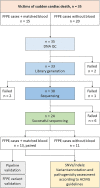Whole exome sequencing of FFPE samples-expanding the horizon of forensic molecular autopsies
- PMID: 36346469
- PMCID: PMC10247852
- DOI: 10.1007/s00414-022-02906-x
Whole exome sequencing of FFPE samples-expanding the horizon of forensic molecular autopsies
Abstract
Forensic molecular autopsies have emerged as a tool for medical examiners to establish the cause of death. It is particularly useful in sudden unexplained deaths where the cause of death cannot be determined with a regular medical autopsy. We provide the first study of exome data from formalin-fixed paraffin-embedded samples (FFPE) paired with data from high-quality blood samples in forensic applications. The approach allows exploration of the potential to use FFPE samples for molecular autopsies and identify variants in extensive exome data. We leverage the high uniformity of the hybridization capture approach provided by Twist Bioscience to target the complete exome and sequence the libraries on a NextSeq 550. Our findings suggest that exome sequencing is feasible for 24 out of a total of 35 included FFPE samples. When successful, the coverage across the exome is comparatively high (> 90% covered to 20X) and uniform (fold80 below 1.5). Detailed variant comparisons for matched FFPE and blood samples show high concordance with few false variants (positive predictive value of 0.98 and a sensitivity of 0.97) with no distinct FFPE artefacts. Ultimately, we apply carefully constructed forensic gene panels in a stepwise manner to find genetic variants associated with the clinical phenotype and with relevance to the sudden unexplained death.
Keywords: Arrhythmia; Cardiomyopathy; FFPE; Molecular autopsy; SCD; WES.
© 2022. The Author(s).
Conflict of interest statement
The authors declare no competing interests.
Figures







Similar articles
-
Using postmortem formalin fixed paraffin-embedded tissues for molecular testing of sudden cardiac death: A cautionary tale of utility and limitations.Forensic Sci Int. 2020 Mar;308:110177. doi: 10.1016/j.forsciint.2020.110177. Epub 2020 Jan 30. Forensic Sci Int. 2020. PMID: 32155531
-
Technical in-depth comparison of two massive parallel DNA-sequencing methods for formalin-fixed paraffin-embedded tissue from victims of sudden cardiac death.Forensic Sci Int Genet. 2021 Jul;53:102522. doi: 10.1016/j.fsigen.2021.102522. Epub 2021 Apr 26. Forensic Sci Int Genet. 2021. PMID: 33945952
-
Performance comparison of two commercial human whole-exome capture systems on formalin-fixed paraffin-embedded lung adenocarcinoma samples.BMC Cancer. 2016 Aug 30;16(1):692. doi: 10.1186/s12885-016-2720-4. BMC Cancer. 2016. PMID: 27578032 Free PMC article.
-
Whole exome sequencing (WES) on formalin-fixed, paraffin-embedded (FFPE) tumor tissue in gastrointestinal stromal tumors (GIST).BMC Genomics. 2015 Nov 3;16:892. doi: 10.1186/s12864-015-1982-6. BMC Genomics. 2015. PMID: 26531060 Free PMC article.
-
A comprehensive assessment of exome capture methods for RNA sequencing of formalin-fixed and paraffin-embedded samples.BMC Genomics. 2023 Dec 15;24(1):777. doi: 10.1186/s12864-023-09886-1. BMC Genomics. 2023. PMID: 38102591 Free PMC article. Review.
Cited by
-
Novel Genetic Variants Associated with Primary Myocardial Fibrosis in Sudden Cardiac Death Victims.J Cardiovasc Transl Res. 2024 Dec;17(6):1229-1239. doi: 10.1007/s12265-024-10527-5. Epub 2024 Jun 7. J Cardiovasc Transl Res. 2024. PMID: 38848015 Free PMC article.
-
Are pre-analytical factors fully considered in forensic FFPE molecular analyses? A systematic review reveals the need for standardised procedures.Int J Legal Med. 2025 Jul;139(4):1439-1452. doi: 10.1007/s00414-025-03480-8. Epub 2025 Apr 2. Int J Legal Med. 2025. PMID: 40172636 Free PMC article.
References
-
- Stiles MK, Wilde AAM, Abrams DJ, Ackerman MJ, Albert CM, Behr ER, et al. 2020 APHRS/HRS expert consensus statement on the investigation of decedents with sudden unexplained death and patients with sudden cardiac arrest, and of their families. Heart Rhythm. 2021;18(1):e1–e50. doi: 10.1016/j.hrthm.2020.10.010. - DOI - PMC - PubMed
MeSH terms
Substances
Grants and funding
LinkOut - more resources
Full Text Sources
Research Materials

